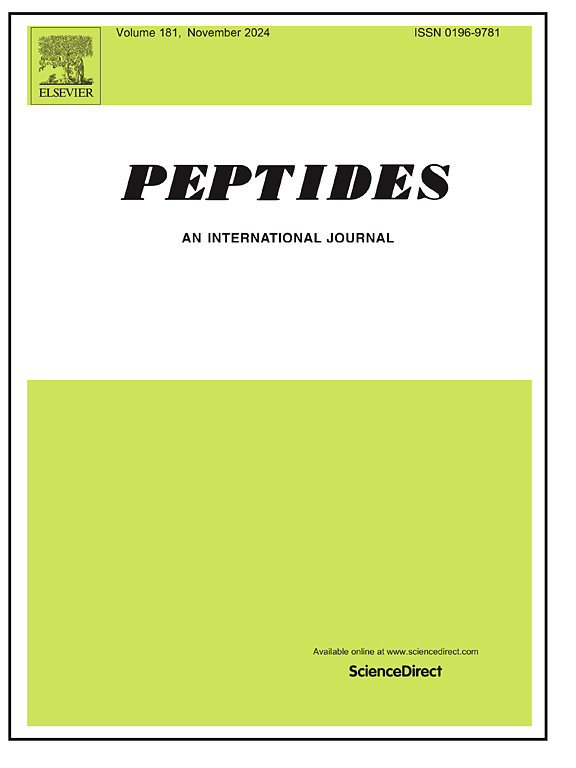甘丙肽受体2和3双敲除对创伤性脑损伤后神经炎症和功能恢复的影响。
IF 2.9
4区 医学
Q3 BIOCHEMISTRY & MOLECULAR BIOLOGY
引用次数: 0
摘要
外伤性脑损伤(TBI)是世界上导致年轻人死亡和残疾的主要原因之一,而TBI相关神经炎症的机制尚不清楚。据推测,调节性神经肽甘丙氨酸(GAL)及其三个受体(GAL1-3R)可调节脑外伤后的神经炎症反应,特别是通过GAL2R和GAL3R信号传导。因此,我们使用GAL2/3R-double-KO (GAL2/3R-KO)小鼠研究galr在中度控制性皮质撞击性脑损伤后急性神经炎症和功能恢复中的作用。分别于脑外伤后第1天和第30天采集脑组织和脑脊液。采用改良神经系统严重程度评分(mNSS)、升高+迷宫(EPM)和Morris水迷宫(MWM)测试评估脑损伤后功能恢复情况。脑外伤后(损伤后第1至28天),GAL2/3R-KO小鼠的神经功能障碍比WT小鼠更严重。在TBI后1天,GAL2/3R-KO和WT小鼠同侧半球的炎症标志物和几种神经生长因子显著增加,与对侧半球相比。术后4天,与假手术小鼠相比,TBI小鼠在EPM中张开手臂的频率明显更高,这表明TBI小鼠的探索行为增加。在TBI后30天,脑切片免疫染色显示,与TBI和假手术小鼠相比,大脑皮层的血管化和胶质瘢痕存在显著差异,但基因型相似。总之,结果表明GAL2R和/或GAL3R在中度脑损伤后具有神经保护作用,因为它们存在时的严重程度明显低于它们不存在时的严重程度。本文章由计算机程序翻译,如有差异,请以英文原文为准。
Impact of galanin receptors 2 and 3 double-knockout on neuroinflammation and functional recovery following traumatic brain injury
Traumatic brain injury (TBI) is one of the world’s leading causes of death and disability in young individuals and the mechanism underlying TBI-associated neuroinflammation is poorly understood. The regulatory neuropeptide galanin (GAL) and its three receptors (GAL1–3R) are assumed to modulate the neuroinflammatory response following TBI, especially by signalling via GAL2R and GAL3R. Therefore, the role of GALRs in acute neuroinflammation and functional recovery following moderate Controlled Cortical Impact TBI was studied using GAL2/3R-double-KO (GAL2/3R-KO) mice. Brains and cerebrospinal fluid (CSF) were collected at day 1 and 30 days post TBI. Functional recovery post TBI was assessed by the modified Neurological Severity Score (mNSS), Elevated Plus Maze (EPM) and Morris Water Maze (MWM) test. Post TBI (day 1–28 post injury), neurological dysfunction was more severe in GAL2/3R-KO mice than in WT mice. At 1 day post TBI, inflammatory markers and several nerve growth factors significantly increased in the ipsilateral hemisphere, compared to the contralateral hemisphere in both GAL2/3R-KO and WT mice. At 4 days post surgery, TBI mice entered significantly more frequent the open-arms in the EPM compared to Sham-operated mice, suggestive of increased exploratory behaviour in TBI mice. At 30 days post TBI, immunostaining of brain sections revealed significant differences in vascularisation and glial scarring in the cortex when comparing TBI and Sham-operated mice, but genotypes were similar. In summary, the results indicate that GAL2R and/or GAL3R have a neuroprotective role following moderate TBI, as the severity was significantly lower in their presence than in their absence.
求助全文
通过发布文献求助,成功后即可免费获取论文全文。
去求助
来源期刊

Peptides
医学-生化与分子生物学
CiteScore
6.40
自引率
6.70%
发文量
130
审稿时长
28 days
期刊介绍:
Peptides is an international journal presenting original contributions on the biochemistry, physiology and pharmacology of biological active peptides, as well as their functions that relate to gastroenterology, endocrinology, and behavioral effects.
Peptides emphasizes all aspects of high profile peptide research in mammals and non-mammalian vertebrates. Special consideration can be given to plants and invertebrates. Submission of articles with clinical relevance is particularly encouraged.
 求助内容:
求助内容: 应助结果提醒方式:
应助结果提醒方式:


